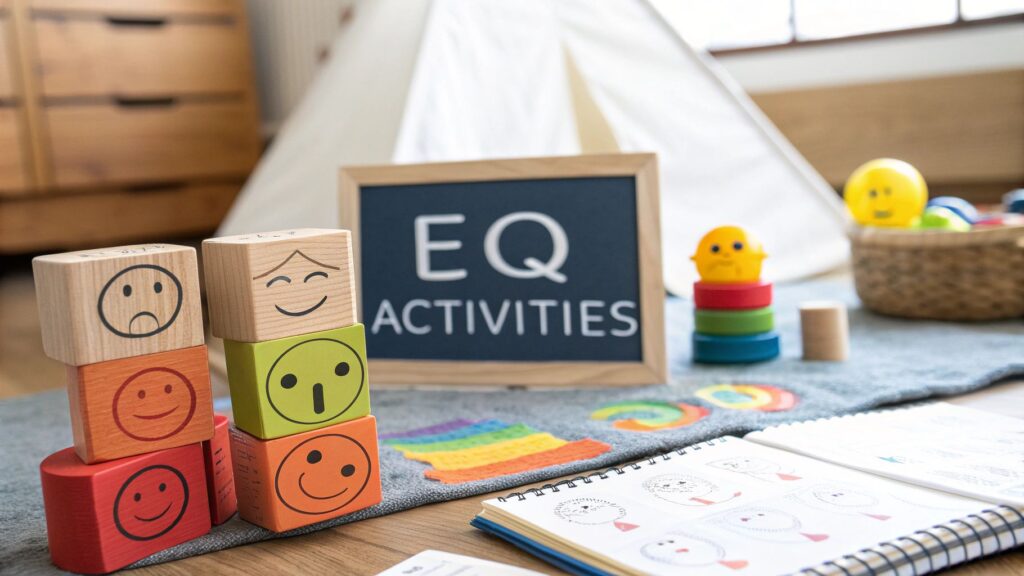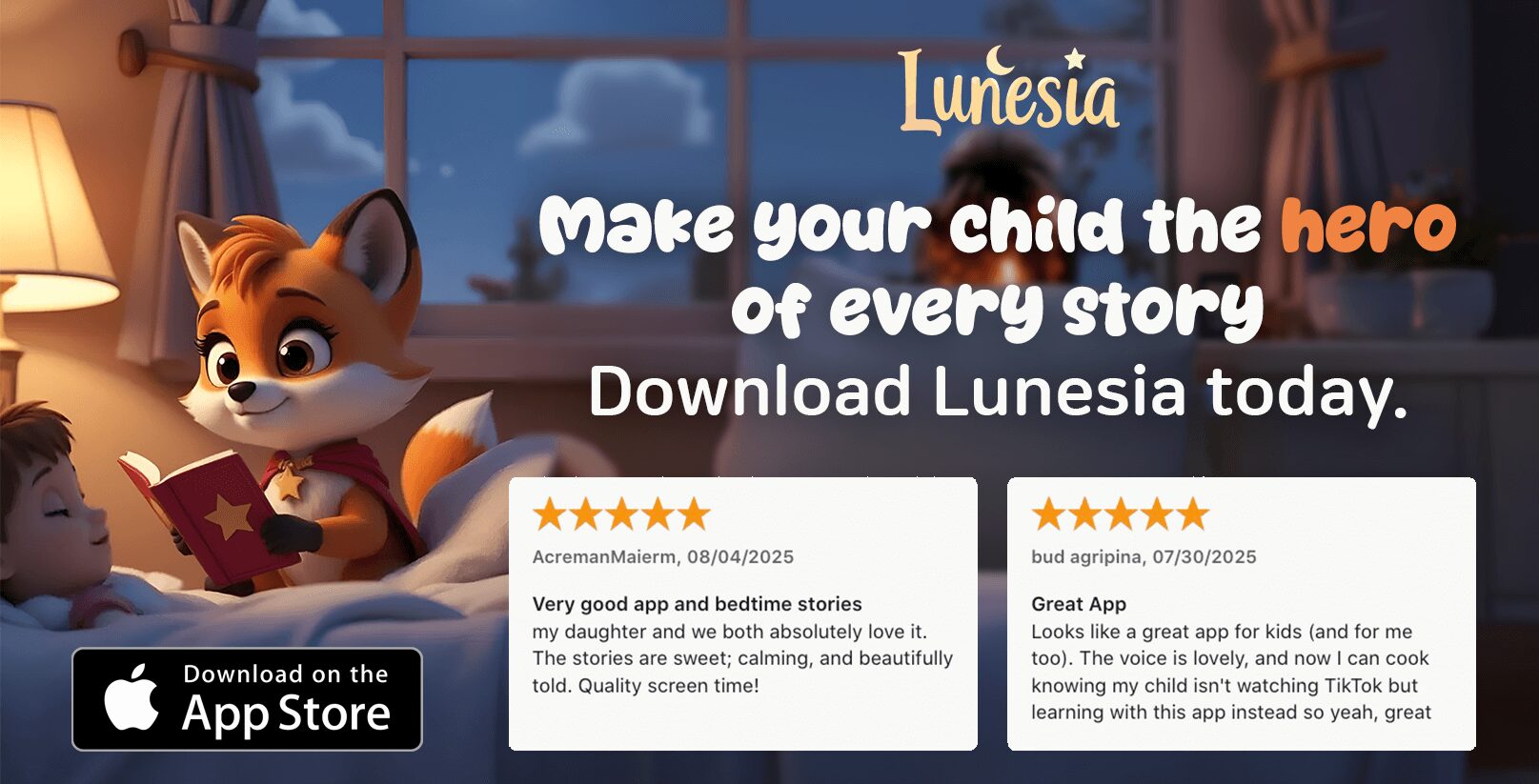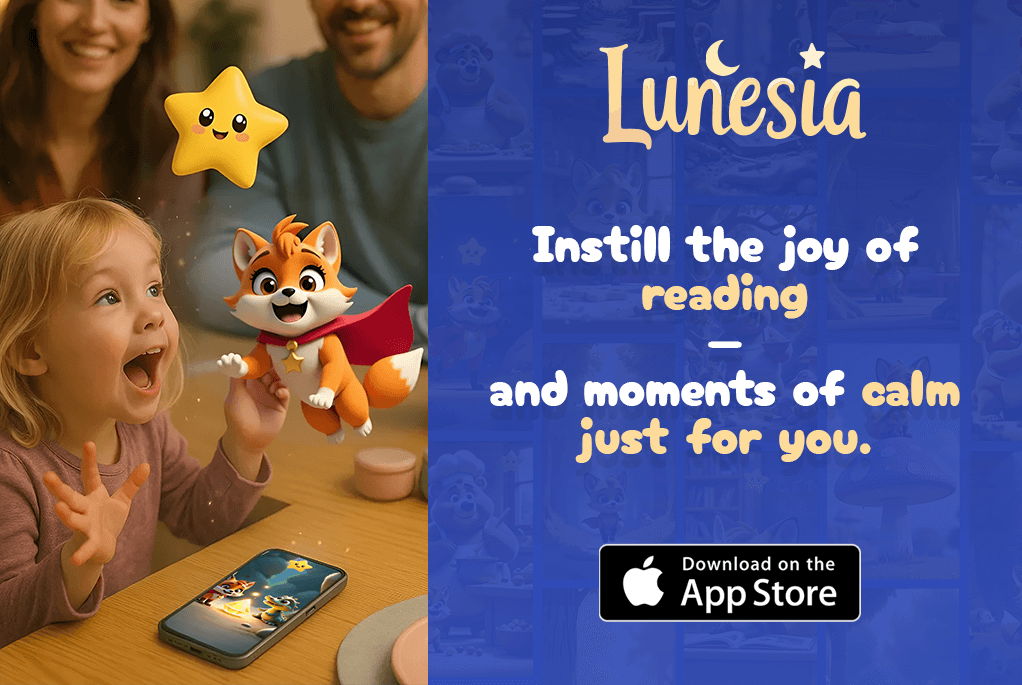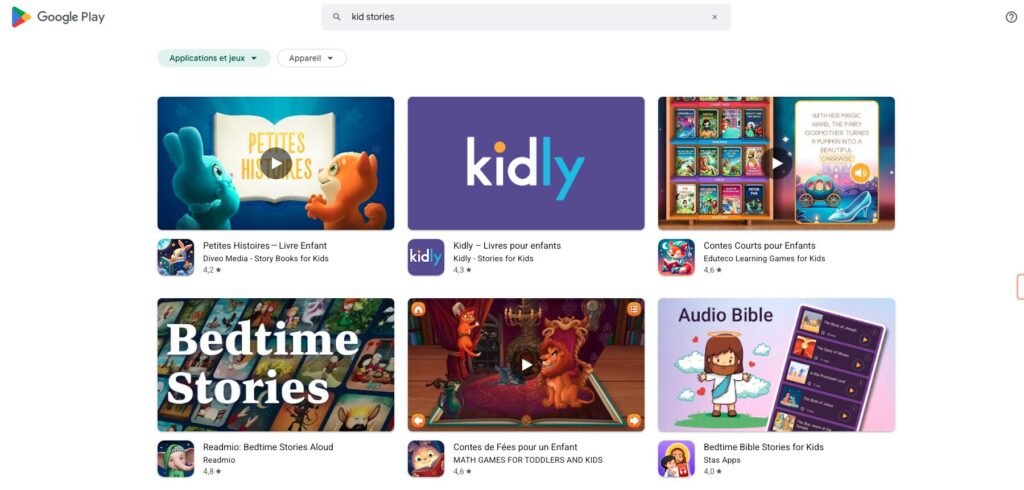Ever feel like you’re negotiating with a tiny, adorable dictator whose demands change by the second? One moment it’s a meltdown over a broken crayon; the next, a full-blown crisis because the toast was cut into squares, not triangles. If you’re nodding along, you’re not alone. What if you could turn these stormy moments into a superpower for your child?
It’s called emotional intelligence (EQ), and research shows that kids with higher EQ aren’t just better behaved. They grow into more resilient, empathetic, and successful adults. In fact, a staggering 90% of top performers in the workplace have high EQ. Ready to give your child that advantage, starting today?
We’ve gathered seven simple, powerful emotional intelligence activities for kids aged 2-7 that you can weave into your daily life right away. Forget feeling overwhelmed. It’s time to trade chaos for connection and equip your child with skills for a lifetime, all while you enjoy a calmer, more harmonious home. Let's dive in.
1. The 'Feeling Faces' Game: Turning Emotional Detectives into Masters of Mood
Ever wonder what’s really going on behind those big, beautiful eyes when your child suddenly gets quiet or bursts into tears? Before they can say, "I feel frustrated," they need to know what frustration even looks like. This simple game turns that process into a playful discovery, making it one of the most foundational emotional intelligence activities for kids.
Using charts or cards with different facial expressions (happy, sad, angry, surprised), you create a fun, low-pressure way for your child to connect a face to a feeling. It’s the essential first step in emotional regulation: you can’t manage a big feeling until you can name it.
How to Play and Why It Works
Ready to play? It’s simple. Show your child a card, like a "sad" face, and say, "This face looks sad. Can you make a sad face?" Then, mirror their expression back to them. This physical act helps wire the connection between the emotion and its physical representation.
Parent Tip: Keep it light and silly! Exaggerate the faces. A big, theatrical gasp for "surprised" or a loud, playful "grrr" for "angry" can turn this into a giggling match instead of a formal lesson.
The goal is to build an emotional vocabulary. Research consistently shows that children who can accurately label their emotions are better equipped to handle them. They experience fewer tantrums and demonstrate more prosocial behaviors like sharing and helping.
Taking It to the Next Level
Once your child can identify basic feelings, you can expand the game.
- Story Time Integration: While reading, pause and ask, "How do you think this character feels right now? Let's find the face on our chart that matches."
- Real-Life Scenarios: If another child at the playground is crying, you can whisper, "It looks like he feels sad. I wonder why." This builds empathy by encouraging your child to consider others' perspectives.
- Introduce Nuance: As they grow, add more complex feelings like "confused," "proud," or "disappointed."
This game lays the groundwork for more sophisticated emotional understanding. It’s the perfect launchpad for interactive tools like the Lunesia app, where children don’t just read a story—they live it. By making decisions for characters who express a wide range of emotions, they see the consequences of feelings and actions in a safe, guided adventure, turning abstract concepts into tangible lessons in kindness and courage.
2. Mindfulness and Breathing Exercises: Helping Kids Find Their Inner Calm
What if you could give your child a secret superpower to hit "pause" when big feelings like anger or frustration take over? That’s exactly what mindfulness and breathing exercises do. They teach children to anchor themselves in the present moment, transforming overwhelming emotions into manageable ones.

This isn't about emptying the mind; it’s about noticing what’s happening inside without judgment. For a child, this might mean learning that the "fizzy" feeling in their tummy is just a feeling—and they have the power to calm it down with their own breath. It’s a foundational skill for self-regulation and one of the most powerful emotional intelligence activities for kids.
How to Practice and Why It Works
Want to try it right now? Have your child lie down and place a favorite small stuffed animal on their belly. Ask them to breathe in slowly through their nose, making the toy rise, and then breathe out slowly through their mouth, making it fall. This visual guide makes the abstract concept of deep breathing concrete and fun.
Parent Tip: Frame it as a game, not a chore. Say, "Let's give your teddy bear a slow, sleepy ride," or "Let's pretend to be a dragon and breathe out long, slow fire." A playful approach prevents resistance and builds positive associations.
The science behind this is compelling. Deep, slow breathing activates the parasympathetic nervous system—the body's natural "calm down" button. Pioneering work by experts like Jon Kabat-Zinn and Daniel Siegel has shown that regular mindfulness practice can physically change the brain, strengthening areas responsible for focus and emotional control.
Taking It to the Next Level
Once your child is comfortable with basic breathing, you can introduce more mindful moments.
- The "5 Senses" Game: On a walk, ask your child to name five things they can see, four things they can feel (like the wind), three things they can hear, two things they can smell, and one thing they can taste. This pulls them into the present moment.
- Create a "Calm-Down Corner": Designate a cozy space with soft pillows where your child can go when they feel overwhelmed. It’s not a time-out; it's a safe retreat for practicing their breathing exercises.
- Practice with Them: Children learn by watching you. Taking a few deep breaths together when you feel stressed models healthy coping skills. Parents can also benefit by exploring mindfulness activities for adults.
These practices build the emotional resilience needed to navigate life's ups and downs. The Lunesia app reinforces these skills through its choice-driven stories. Characters often face challenges that teach them to pause and think before reacting—mirroring the very self-awareness these exercises cultivate and turning screentime into skill-building time. Learn more about mindfulness activities ideal for preschoolers to expand your toolkit.
3. Social Stories and Role-Playing Scenarios: Rehearsing for Real Life
Ever wished you could give your child a script for tricky social situations, like sharing a toy or joining a new group at the park? That's exactly what social stories and role-playing do. They offer a safe, guided rehearsal for real-world interactions, making them one of the most effective emotional intelligence activities for kids.
This narrative-based approach helps children understand social cues, practice appropriate responses, and build empathy by seeing situations from another person’s point of view. You’re not just telling them what to do; you're helping them understand the why behind social expectations.
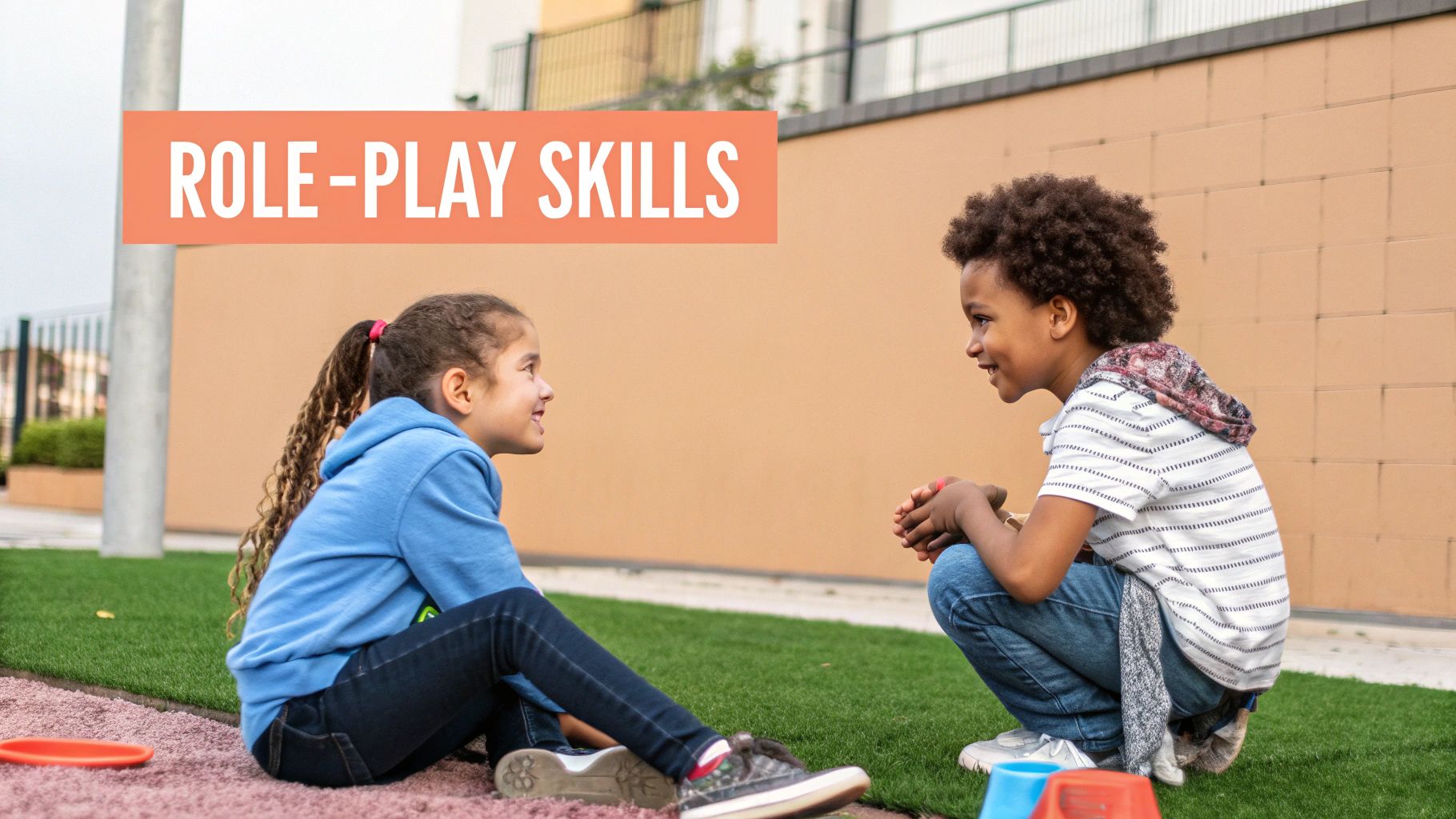
How to Play and Why It Works
The magic of this method is its simplicity. Let's say your child is anxious about going to preschool. You could create a short, simple story: "When Mommy drops me off, I might feel a little sad. That's okay. My teacher will be there to say hello. There will be fun toys to play with, and soon it will be time to go home."
Parent Tip: Use puppets or stuffed animals as the characters! This creates a playful distance, making it easier for children to explore big feelings without feeling self-conscious. Let them direct the "play" and explore different outcomes.
This works because it demystifies social interactions. By rehearsing a scenario, you create neural pathways that make the real-life situation feel more familiar and less intimidating. This builds a child's confidence and reduces anxiety, turning fear of the unknown into a feeling of, "I've practiced this before!"
Taking It to the Next Level
Once you've mastered simple stories, you can expand the practice to build deeper emotional skills.
- Role Reversal: Ask your child to play the other person's role. If the conflict is about sharing, let them be the child who wants the toy. This is a powerful empathy-building exercise.
- Problem-Solving Together: Instead of providing the solution, ask, "What could the little bear do next?" This encourages critical thinking and empowers them to find their own positive solutions.
- Practice Challenging Scenarios: Role-play what to do when another child is unkind or how to ask for help from a grown-up. This prepares them for tough moments in a safe setting.
This guided practice is at the very heart of what makes Lunesia so powerful. In Lunesia’s adventures, children are constantly put in the shoes of a character facing a choice. Should they share their special berries with a sad creature or keep them? By making the decision and seeing the outcome, they aren't just hearing about empathy—they're practicing it, turning abstract lessons into deeply felt experiences.
4. Emotion Journaling and Art Expression: Coloring Outside the Lines of Big Feelings
What happens when the biggest feelings are the ones with no words? When a child can't explain why they’re upset or overwhelmed, giving them a crayon can be like handing them a key. This creative method helps children process complex emotions without the pressure of finding the right words, making it one of the most powerful emotional intelligence activities for kids.
Expression through art gives feelings a shape, a color, and a form. A scribbled black crayon mess can represent anger, while a bright yellow sun might show happiness. This isn't about creating a masterpiece; it's about providing a safe outlet for the emotional world inside.
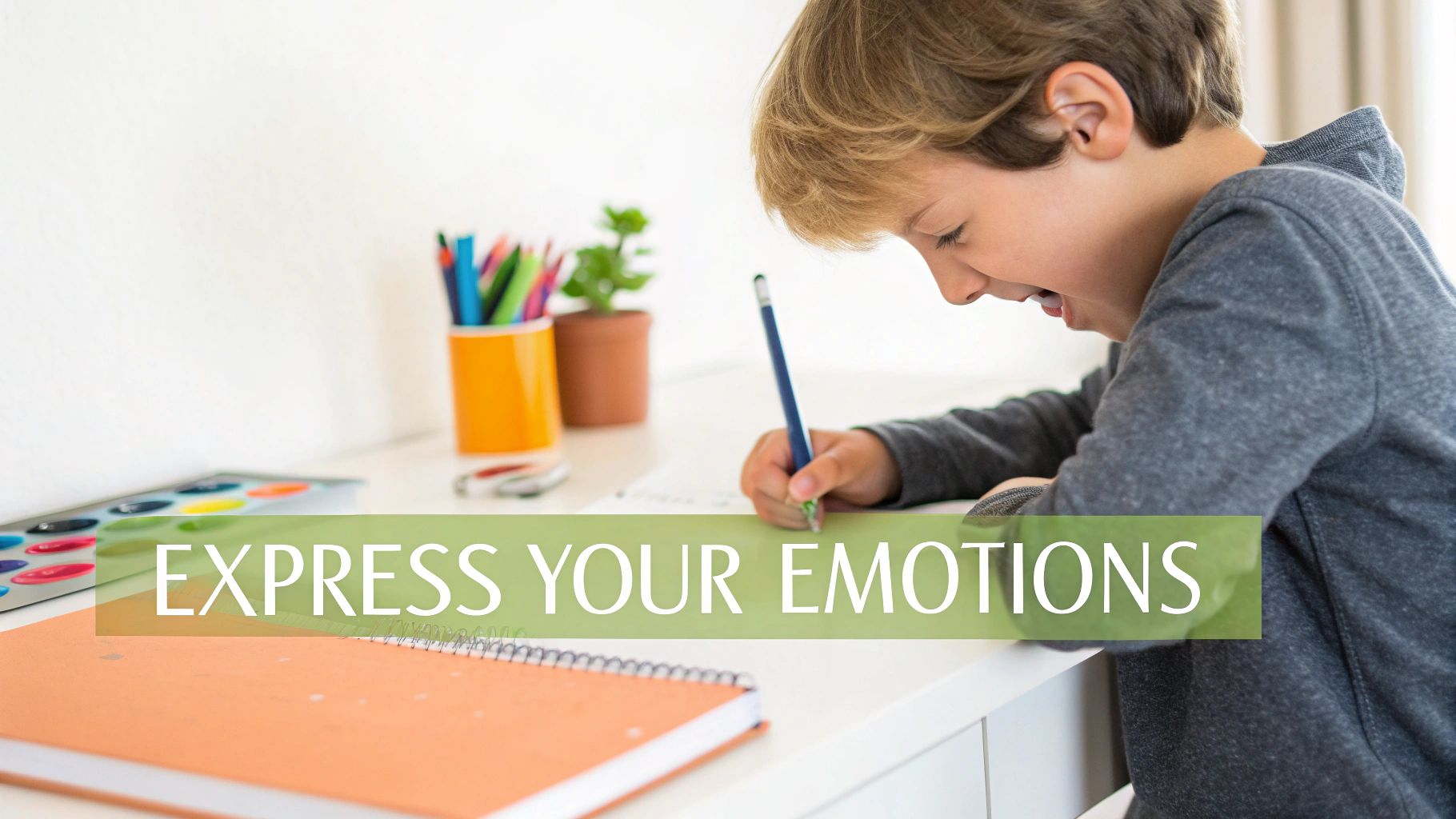
How to Play and Why It Works
The beauty of art expression is its simplicity. Set out some paper and a few art supplies and say, "Let's draw what our feelings look like today." You don't need to guide them further. The goal is to let their internal state pour onto the page, creating a tangible representation of their emotions that you can talk about together.
Parent Tip: Focus on the process, not the product. Say things like, "I see you're using a lot of red. That looks like a very strong color," instead of "What are you drawing?" This keeps the focus on expression rather than artistic skill.
This approach builds self-awareness and emotional regulation. Art therapy research shows that creative expression can lower stress and anxiety in children. By giving a physical form to their feelings, kids can feel more in control of them. It externalizes the emotion, so they can look at it instead of being consumed by it.
Taking It to the Next Level
Once your child is comfortable with basic expression, you can deepen the practice.
- Create an "Emotion Journal": Dedicate a special notebook where they can draw or write about their feelings each day. It becomes a private, safe space for them to check in with themselves.
- Use Story Prompts: Ask, "Can you draw a picture of a time you felt really brave?" or "What does a worried monster look like?" This can help them explore specific emotions.
- Introduce Different Mediums: Try play-doh for squishing out anger, watercolors for "calm" feelings, or collage for when emotions feel messy and mixed up.
This hands-on approach perfectly complements the digital storytelling in an app like Lunesia. After an adventure where a character faces a big challenge, you can ask your child to draw how the character might have felt. This bridges the gap between a story’s lesson and your child’s own emotional experience, making abstract concepts like empathy and resilience concrete and personal.
5. Empathy Building Games and Activities: Stepping into Someone Else's Shoes
Have you ever seen your child snatch a toy and be completely baffled by the other child's tears? This isn't malice; it's a developing brain learning that other people have feelings, too. Empathy isn't just a trait people are born with—it's a skill we can build. Interactive games are the perfect way to make this complex lesson feel like natural, compassionate fun.
These activities move beyond simply naming feelings to understanding why someone feels that way. By practicing perspective-taking, children learn to think, "What would it be like to be them?" This is a cornerstone of social awareness and a vital component of emotional intelligence activities for kids that create kind, connected individuals.
How to Play and Why It Works
Start with simple "what if" scenarios. You can say, "Imagine your friend fell and scraped their knee. What could we do to help them feel better?" This encourages your child to connect an event to an emotional reaction and then to a helpful action, forming the complete empathy loop.
Parent Tip: Use puppets or stuffed animals to act out situations. This creates a safe distance, allowing your child to explore big feelings like sadness or loneliness without feeling overwhelmed themselves.
The goal is to make compassion a reflex. When children regularly practice considering others' perspectives, they are more likely to share, comfort a friend, and cooperate. This social competence is a powerful predictor of future success and well-being, leading to stronger friendships and better conflict-resolution skills.
Taking It to the Next Level
Once they grasp the basics, you can deepen their understanding of empathy.
- Kindness Missions: Create a "Kindness Jar" with simple acts on slips of paper, like "Give someone a compliment" or "Help set the table." Make it a fun family challenge.
- "Read" the Room: At a park or family gathering, quietly observe people and ask, "What do you think that person is feeling? What makes you think so?" This sharpens their observational skills.
- Connect to Community: Get involved in simple service projects, like making cards for a local nursing home. This shows them how their small, empathetic actions can have a big, positive impact on others.
These games teach children that their actions matter. For more ideas on nurturing this crucial skill, you can explore resources on developing empathy in preschoolers. These activities build the foundation that apps like Lunesia expand upon, allowing kids to step into a character’s shoes in an interactive story, make compassionate choices, and see the beautiful results unfold.
6. Conflict Resolution and Problem-Solving Workshops
When your child grabs a toy from a friend, or a disagreement on the playground turns into a full-blown meltdown, how do you teach them to navigate those tricky moments? Structured activities focused on conflict resolution provide the tools they need to turn arguments into agreements. You can create mini-workshops at home that empower your child to become a peacemaker.
This approach teaches children that disagreements are normal, but how we handle them makes all the difference. It shifts the focus from "winning" an argument to finding a solution where everyone feels heard—a core component of advanced emotional intelligence activities for kids.
How to Play and Why It Works
The key is to teach these skills during calm, happy moments, not in the heat of a conflict. Start with a simple, step-by-step problem-solving guide. For example, you can create a "Peace Path" on the floor with designated spots for: 1. Say how you feel. 2. Listen to the other person. 3. Think of solutions together. 4. Agree on one.
Parent Tip: Use puppets to act out common conflicts, like sharing a favorite truck. Let your child guide the puppets through the problem-solving steps. This creates a safe, playful distance from the issue, making it easier for them to learn without feeling defensive.
The goal is to equip them with a script for tough situations. When kids have a clear process to follow, they are less likely to resort to hitting, yelling, or crying. This builds their confidence and teaches them that they have the power to solve their own interpersonal problems.
Taking It to the Next Level
Once they understand the basic steps, you can apply them to more complex scenarios.
- Family Problem-Solving Meetings: For recurring issues, like bedtime battles, hold a short family meeting. Use a whiteboard to list everyone's ideas and circle the one you'll try together.
- Real-Life Coaching: When a small conflict arises, step in as a coach, not a referee. Gently prompt, "It sounds like you both want the red crayon. What are some fair ways we could solve this?"
- Introduce "I Feel" Statements: Teach them to express their needs without blaming, using the classic formula: "I feel [feeling] when you [action] because [reason]."
These strategies build a foundation for healthy relationships. Interactive stories, like those in the Lunesia app, offer a perfect practice ground where children see characters face and resolve conflicts. By making choices for the characters, kids explore the outcomes of different problem-solving approaches in a safe, engaging narrative. Learn more about problem-solving with Lunesia and see how interactive play can transform abstract lessons into lasting skills.
7. The Gratitude Jar: Cultivating Happiness One Thankful Thought at a Time
Ever notice how quickly a child's focus can shift to the one toy they don't have, overlooking a room full of treasures? Shifting that mindset from scarcity to appreciation is a cornerstone of emotional resilience. This is where gratitude practices come into play, making them one of the most transformative emotional intelligence activities for kids.
By creating simple, daily rituals around thankfulness, you help your child’s brain build pathways for optimism and contentment. It teaches them to actively look for the good, a skill that fosters well-being and helps them weather life's disappointments with grace.
How to Play and Why It Works
The concept is beautifully simple: create a "Gratitude Jar" or start a "Three Good Things" ritual before bed. Each day, encourage your child to name one or three things they are thankful for. It could be a warm hug, a fun game at the park, or the yummy snack they had. Write it on a small slip of paper and add it to the jar.
Parent Tip: Be specific and lead by example. Instead of "I'm grateful for my family," try "I'm grateful for the way you giggled when we built the block tower together today." This teaches your child to notice the small, meaningful moments.
This practice physically rewires the brain. Studies by researchers like Robert Emmons show that regularly practicing gratitude can increase happiness levels and reduce depressive symptoms. For children, it builds a foundation of positive thinking, making them more resilient and optimistic.
Taking It to the Next Level
Once this becomes a habit, you can deepen the practice.
- Strength Spotting: Acknowledge your child's inner strengths. Say, "You showed so much courage when you tried the tall slide today!" or "That was very kind of you to share your crayons."
- Gratitude in Action: Connect feeling thankful to doing good. "We're so lucky to have warm coats. Let's pick out one to donate to someone who needs it."
- Visual Reminders: Create a "gratitude tree" on a wall where you hang paper leaves with things you're thankful for, creating a beautiful, evolving display of your family's joy.
These activities don't just teach children to say "thank you;" they teach them to feel it. This shift in perspective is echoed in Lunesia, where stories often center on characters who find strength in kindness and appreciation. By engaging in these narratives, children see how positive mindsets lead to better outcomes, reinforcing the powerful lessons you’re teaching at home in a fun, interactive way.
Emotional Intelligence Activities Comparison Guide
| Item | Implementation Complexity 🔄 | Resource Requirements ⚡ | Expected Outcomes 📊 | Ideal Use Cases 💡 | Key Advantages ⭐ |
|---|---|---|---|---|---|
| Feeling Faces Charts and Emotion Identification Games | Low to moderate; easy to set up | Minimal (charts, cards, discussion) | Foundational emotional awareness and vocabulary | Early childhood emotional literacy (3-12 years) | Builds core vocabulary; multi-sensory; adaptable |
| Mindfulness and Breathing Exercises | Moderate; requires consistent practice | Low (quiet space, optional apps) | Improved self-regulation, reduced anxiety | Focus and emotional regulation (4-18 years) | Scientifically supported; portable; builds focus |
| Social Stories and Role-Playing Scenarios | Moderate to high; adult facilitation needed | Moderate (time and facilitation) | Empathy, social skills, problem-solving | Social skills development, behavioral challenges (5-16 years) | Safe environment to practice; customizable |
| Emotion Journaling and Art Expression | Moderate; needs materials and support | Moderate (supplies, space) | Emotional processing, self-awareness, creativity | Emotional expression and reflection (6-18 years) | Accommodates diverse styles; therapeutic |
| Empathy Building Games and Activities | Moderate to high; skilled facilitation recommended | Low to moderate (games, materials) | Increased prosocial behavior, relationship building | Social awareness and compassion (4-16 years) | Builds empathy; reduces bullying; inclusive |
| Conflict Resolution and Problem-Solving Workshops | High; adult training and consistent reinforcement | Moderate to high (training, materials) | Conflict management skills, better communication | Interpersonal conflicts, life skills (8-18 years) | Empowers problem-solving; reduces conflicts |
| Gratitude and Positive Psychology Practices | Low; easily integrated daily | Minimal (journals, prompts) | Enhanced happiness, resilience, relationships | Emotional well-being and motivation (5-18 years) | Improves mental health; easy to implement |
Your Journey to Raising an Emotionally Intelligent Child Starts Now
Navigating the world of big emotions with a little one can feel like a monumental task, but you’ve just equipped yourself with a powerful toolkit. The journey of raising an emotionally intelligent child isn’t about perfection; it’s about connection. It’s about seizing the small, everyday moments—the scraped knee, the fight over a toy, the fear of the dark—and transforming them into foundational lessons in kindness, resilience, and self-awareness.
The emotional intelligence activities for kids we’ve explored are more than just games. They are invitations for your child to understand the complex world inside them and the people around them. These practices build a vocabulary for feelings, empowering your child to articulate their needs and navigate social challenges with confidence. Think of each activity not as another item on your to-do list, but as a new way to bond and build a relationship based on trust and understanding.
Turning Theory into Daily Practice
So, where do you begin? The key is to start small and be consistent.
- Choose one activity that resonates with you and your child’s personality. Is your child a natural artist? Start with emotion journaling. Do they love stories? Lean into role-playing different social scenarios.
- Integrate it naturally. Turn car rides into a game of "I spy a feeling" or make mindful breathing a regular part of your bedtime routine. Consistency is far more impactful than intensity.
- Model the behavior. Let your child see you identifying your own emotions. Saying, "I'm feeling a little frustrated because I can't find my keys, so I’m going to take a deep breath," is one of the most powerful lessons you can teach.
Remember, you are your child's primary emotional coach. By embracing these emotional intelligence activities for kids, you are not just managing tantrums or sibling squabbles. You are laying the groundwork for a future adult who is empathetic, a skilled problem-solver, and a compassionate friend. You're giving them the tools to build healthier relationships, succeed in school, and navigate life with grace.
And for those moments when you need support? Technology can be an incredible ally. When you need a moment to recharge without the guilt of plopping your child in front of mindless content, tools like Lunesia can step in. Its interactive stories aren’t just entertainment; they are immersive adventures where children make choices that teach empathy, courage, and problem-solving. While you gain that precious time for yourself, your child is in a safe, ad-free environment, actively building the very emotional intelligence skills you’re working so hard to foster.
Ready to give your child a fun, engaging way to build emotional resilience while you enjoy a guilt-free break? Explore the world of Lunesia, where interactive stories turn playtime into powerful lessons in kindness and courage. Discover how Lunesia can support your family's emotional intelligence journey today.
